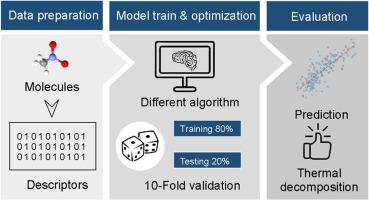基于机器学习的含能材料分解温度预测与解释
IF 3.9
Q2 CHEMISTRY, MULTIDISCIPLINARY
引用次数: 0
摘要
探索机器学习(ML)在含能材料(EMs)中的应用一直是一个研究热点。因此,利用机器学习方法预测电磁爆轰特性受到了广泛的关注。然而,EMs热分解温度(Td)的预测模型鲜有报道。此外,这些报告中使用的小数据集导致预测模型的泛化能力较弱。本研究创建了包含1022个Td值为38-425°C的高能分子数据集,并通过训练确定了最优预测模型。梯度增强机回归(GBR)模型对测试集的决定系数(R2)为0.65,平均绝对误差(MAE)为27.7。本研究进一步探索了关键特征,确定了模型的预测精度受到表征分子键稳定性(即BCUT指标)和原子组成(即分子ID)的描述符的显著影响。最后,对离群结构的分析表明,加入分子相互作用的相关特征可以进一步提高模型的精度。本研究的结果有助于深入理解机器学习在EM属性预测中的应用,特别是在数据集构建和特征选择方面。本文章由计算机程序翻译,如有差异,请以英文原文为准。


Machine learning-based prediction and interpretation of decomposition temperatures of energetic materials
Exploring the application of machine learning (ML) in energetic materials (EMs) has been a hot research topic. Accordingly, the prediction of the detonation properties of EMs using ML methods has attracted much attention. However, the predictive models for the thermal decomposition temperatures (Td) of EMs have been scarcely reported. Furthermore, the small datasets used in these reports lead to a weak generalization ability of the predictive models. This study created a dataset containing 1022 energetic molecules with Td values of 38–425 °C and determined an optimal predictive model through training. The gradient boost machine for regression (GBR) model yielded a coefficient of determination (R2) of 0.65 and a mean absolute error (MAE) of 27.7 for the test set. This study further explored critical features, determining that the prediction accuracy of the models was significantly influenced by descriptors representing molecular bond stability (i.e., the BCUT metrics) and atomic composition (i.e., the Molecular ID). Finally, the analysis of the outlier structure indicated that the model accuracy can be further improved by incorporating features related to molecular interactions. The results of this study help gain a deep understanding of the application of ML in the prediction of EM properties, particularly in dataset construction and feature selection.
求助全文
通过发布文献求助,成功后即可免费获取论文全文。
去求助
来源期刊

Energetic Materials Frontiers
Materials Science-Materials Science (miscellaneous)
CiteScore
6.90
自引率
0.00%
发文量
42
审稿时长
12 weeks
 求助内容:
求助内容: 应助结果提醒方式:
应助结果提醒方式:


